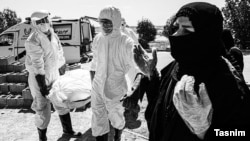An Iranian Health Ministry deputy on Monday said lifting coronavirus restrictions on businesses does not mean "going back to normal" and can be reversed if the number of infections and deaths go up.
Since April 12 Iran has started relaxing lockdown measures and allowed some factories, businesses, malls, arcades and parks to open to the public amid fears of a rebound. Cities and towns have now been divided into three categories of red, yellow and white to allow separate measures to be adopted about resumption of businesses and religious gathering such as Friday prayers in less critical areas.
Health Ministry officials say 116 of the 436 Iranian cities and towns with a total population of 15 million have been tagged white while 60 cities, including most provincial capitals, are in the critical red category. The places tagged white have not registered any coronavirus hospitalizations in the past two weeks, they say.
According to Deputy Health Minister Iraj Harirchi a few cities including Tehran have had high numbers of hospitalizations of up to 70 in the same period. The government has never announced the number of cases and deaths from COVID-19 in the capital Tehran and Tehran Province.
The refusal to release the COVID-19 cases and fatality numbers for the capital has led to challenges from lawmakers, Tehran City Council members and others. On Monday. Mohsen Hashemi, the reformist Chairman of Tehran City Council who challenged the Health Ministry for hiding the numbers.
According to Hashemi, the Council can acquire the death figures from the municipality-run main cemetery in the capital. Hashemi, however, fell short of revealing the numbers himself.
While the Health Ministry says its figures only reflect test-confirmed cases, an advisory report by the Parliament's research arm released on April 15 estimated that the real number of coronavirus cases in the country could be up to 10 times higher than the ministry's figures. According to the report, the number of deaths could also be twice as many as what the Health Ministry announces.
According to the latest official statement of the Health Ministry on Monday with 96 deaths in the last 24 hours, the total death toll since February 19 reached 5,806. However, in the same reporting period, the number of new cases dropped below 1,000 for the first time in more than a month, bringing the total cases to 91,472. More than 3,000 COVID-19 patients are now in a critical situation, the Health Ministry Spokesman Dr. Kianoush Jahanpur said.
Iran's religious establishment has been insisting on opening mosques and shrines to the public and holding Friday prayers as soon as possible but according to Deputy Health Minister Harirchi, lockdown measures will only be rolled back in places tagged white where Friday prayers can be resumed in smaller groups. The situation in these places will be monitored every four days and adjusted if required, he said.
"We will not allow public gatherings of several hundred or several thousand people until we can evaluate the effect of the rollbacks," Harirchi insisted and added that the implementation of what the Iranian government calls "intelligent social distancing" is "a kind of wargame against the coronavirus because we may have to face new infection cases in fall and winter", even if the epidemic appears to be contained during the summer. The virus can always come back from another source, he said.










